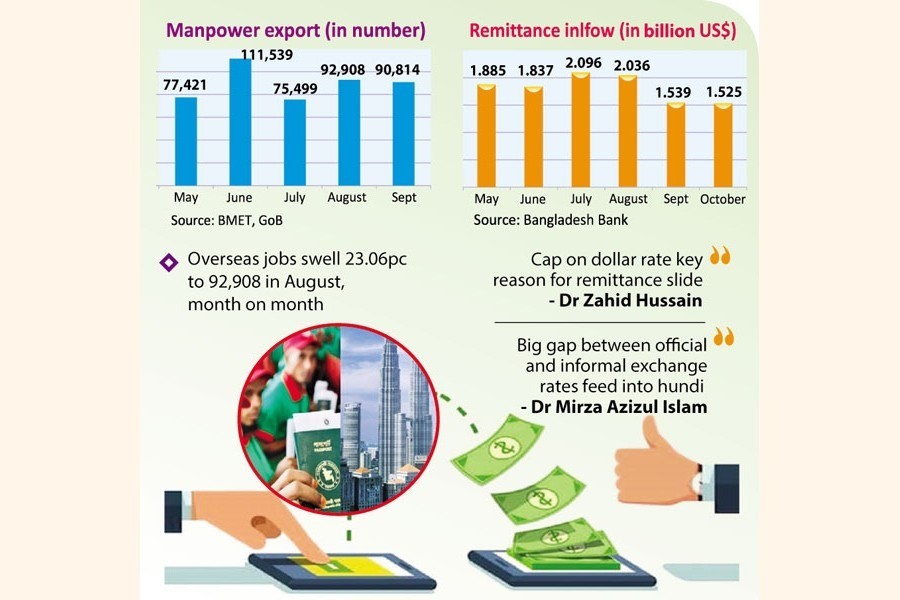The correlation between manpower export and remittance inflow shows a mismatch in recent months, arousing apprehension about misdirection of foreign currencies earned by the expatriates.
The correlation between manpower export and remittance inflow shows a mismatch in recent months, arousing apprehension about misdirection of foreign currencies earned by the expatriates.
An FE analysis finds that the remittance of wage-earners' money, a key toll of Bangladesh's foreign- exchange reserves, has been on a downturn of late although overseas job registrations recorded higher trend.
Economists say this is very interesting to note that despite a higher US dollar rate provided to the remitters, the remittance income has suddenly dipped against a better growth in overseas employment.
They see cap on the USD exchange rate for the remittance by the banks as a key reason for the fall in the foreign-exchange earnings from the Bangladesh expatriates-and that at a time when the country feels the pinch of a global financial crunch.
According to Bangladesh Bank (BB), the remittance inflow started ebbing down in August and the descent continued into the last month of October. In July this year, the remittance flow into Bangladesh was highest over the past few months' receipts.
Contrarily, the country sent out higher numbers of jobseekers during August-September period compared to the previous month July this year.
According to BBS data, the expatriates sent home US$2.09 billion in July and thereafter came down the sloth in following months-August, September and October.
The month-on-month remittance inflow dropped 2.92 per cent in August to $2.03 billion, by 32.30 per cent to $1.54 billion in September and by 0.92 per cent to $1.52 billion in October.
Meanwhile, the month-on-month overseas employments swelled by 23.06 per cent to 92,908 in August compared to the previous month July.
In September, the manpower export for overseas jobs had also maintained almost similar trend with 90,814 workers going abroad, Bangladesh Manpower Employment and Training (BMET) data showed.
The FE analysis has found that the manpower exports in nine months (January-September) of the current year 2022 to different overseas job markets have already crossed the figure of the 12 months in the past year (2021).
BMET's statistics show that a total of 873,739 jobseekers went abroad during Jan-Sep period of the current calendar year compared to 617,209 during Jan-December 2021.
Former World Bank Lead Economist Dr Zahid Hussain told the FE that imposing cap on the USD exchange rate for inward remittance is the key reason for the fall.
"Look at the month-on-month remittance-inflow trend. In the first two weeks of September, Bangladesh received nearly $1.0 billion worth of remittance. But it started to fall from the 3rd week. During 3rd and 4th weeks of September, the workers sent some $500 million. In October, the remittance fell further."
This was happening due to imposition of the cap on the USD exchange rate by the banks in the middle of September, Dr Hussain said.
On September 11, commercial banks capped the rates of the dollar at Tk108 for remittance and Tk99 for export proceeds as part of an effort to curb volatility on the country's foreign-exchange market.
Dr Hussain explains the conundrum: If a Bangladeshi expatriate in an overseas country sends foreign exchange to Bangladesh through exchange house, his family will get money at Tk 108 against a USD from the exchange house and Tk 99 from the banks and non-banking institutions. At the same time, he can get Tk 112-116 in the informal channel.
"So, why the person sends his hard-earned money at a lower rate rather than opting for a much higher rate, offered by the informal channels," the WB economist says.
Former Finance Adviser of a caretaker government Dr Mirza Azizul Islam also says the regulation of the USD exchange rate is the main reason for the falling trend in remittance.
"I have still failed to understand the BB's policy on the exchange rate. The BB says that the USD rate is floating but the banks imposed cap on it. So, these factors are affecting the remittance inflow despite a better trend in overseas employments," he told the FE.
Mr Islam points out a big gap between the formal USD rate at the banks and exchange houses, and the informal channels, resulting in the plunging of remittances in the formal channel and hopefully rising in the informal channel or in 'hundi'.


